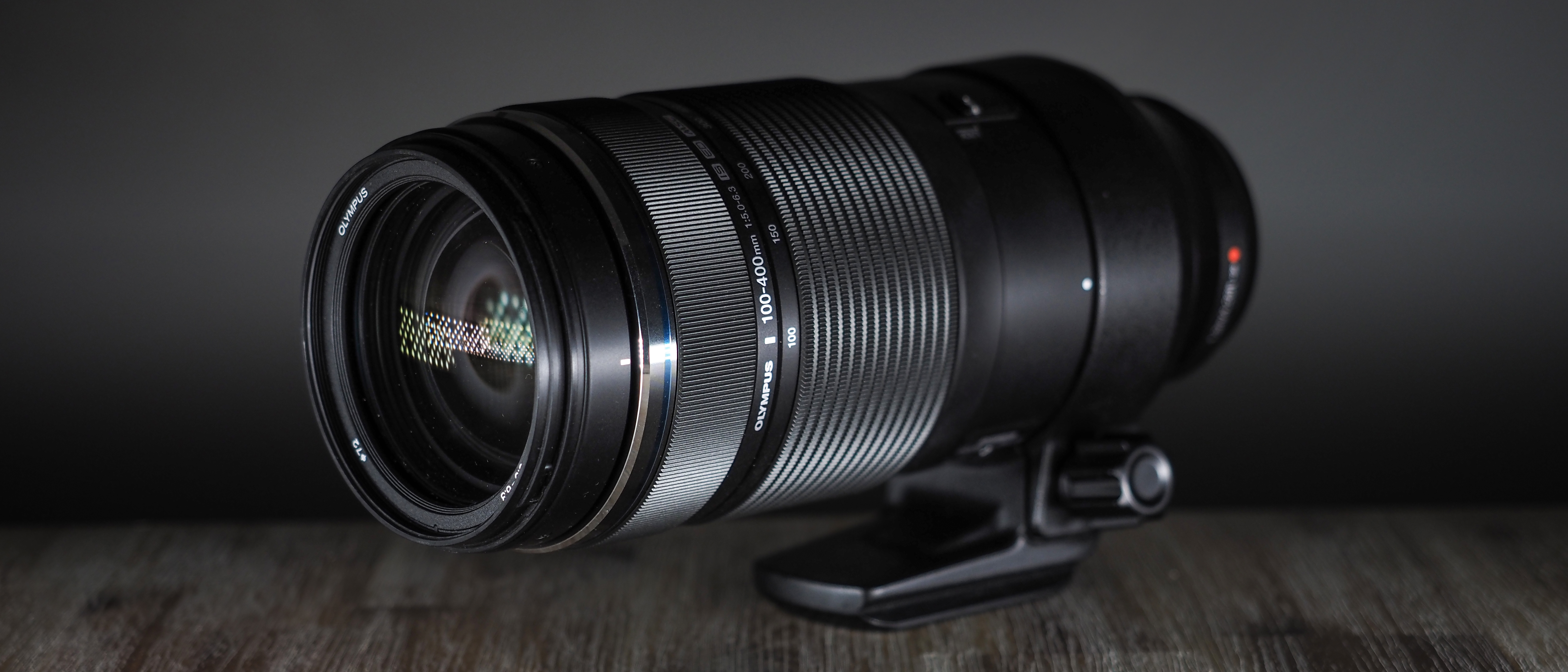Digital Camera World Verdict
The Olympus M.Zuiko 100-400mm f/5.0-6.3 IS delivers pleasing results overall – albeit with the usual caveats that it's not at its sharpest when shooting at its maximum focal length, and you can't expect an f/6.3 lens to achieve the same results as faster and more expensive glass. It supports Olympus' teleconverters and focus stacking, making it very flexible for super telephoto and telemacro work. For portable 800mm images with performance on par with the price and speed, the Olympus 100-400mm f/5.0-6.3 is an easy lens to love for stills and video alike.
Pros
- +
Huge 200-800mm range
- +
Lightweight and compact
- +
Supports teleconverters
- +
Weather sealed
Cons
- -
Quirky stabilization
- -
Panasonic lens is faster
- -
Could be sharper
Why you can trust Digital Camera World
The Olympus M.Zuiko 100-400mm f/5.0-6.3 IS represents the key strengths of the Micro Four Thirds format: compact size, light weight and a ridiculous amount of reach for such a small package.
This is all made possible not only thanks to the clever design of the Olympus M.Zuiko 100-400mm f/5.0-6.3 IS itself, but because of the small size of the Micro Four Thirds image sensors inside the best Olympus cameras. Their 2x crop factor means that, to calculate the equivalent 35mm range of an attached optic, you multiply the focal length by 2x – which makes this latest Olympus lens a whopping 200-800mm.
Not only that, the lens is also compatible with the Olympus M.Zuiko Digital 2x Teleconverter MC-20 and 1.4x Teleconverter MC-14 – which means that you can extend the maximum focal length to an enormous 1600mm.
It all sounds great on paper, but how does the lens handle in practice – does it live up to the brilliant reputation of the best Olympus lenses, or does it live down to the reputation of many less-than-stellar 100-400mm f/6.3 zooms?
Specifications
Mount: Micro Four Thirds
Full frame: No
Autofocus: Yes
Image stabilization: 3-stops
Lens construction: 21 elements in 15 groups
Angle of view: 12-3.1 degrees
Diaphragm blades: 9
Minimum aperture: f/22
Minimum focusing distance: 1.3m
Maximum magnification ratio: 0.17 (wide) / 0.57x (tele)
Filter size: 72mm
Dimensions: 205.7 x 86.4mm
Weight: 1,120g (excluding tripod bracket, caps, lens hood)

Key features
The Olympus M.Zuiko 100-400mm f/5.0-6.3 IS comes with the weather sealing and freeze-proofing that is normally reserved for Olympus' series of Pro lenses – though it doesn't feature the Sync-IS system featured in Pro glass (which works in tandem with the in-body image stabilization of Olympus cameras, to provide extra stability), instead offering 3-stops of compensation via lens IS.
With a close focus distance of 1.3m across throughout the entire focal range, the lens adds a telemacro feather to its cap. The ability to combine telephoto and macro shooting makes the Olympus 100-400mm more versatile than its super tele zoom capabilities might suggest.
The optical formula features some of Olympus' best lens technology, including four Extra-low Dispersion lenses (to suppress color bleeding), and two Super High Refractive Index lenses and and two High Refractive Index lenses for edge-to-edge brightness and clarity across the full zoom range.
It also possesses Zuiko Extra-low Reflection Optical Coating, which reduces ghosting and flare even in difficult conditions (such as backlighting).
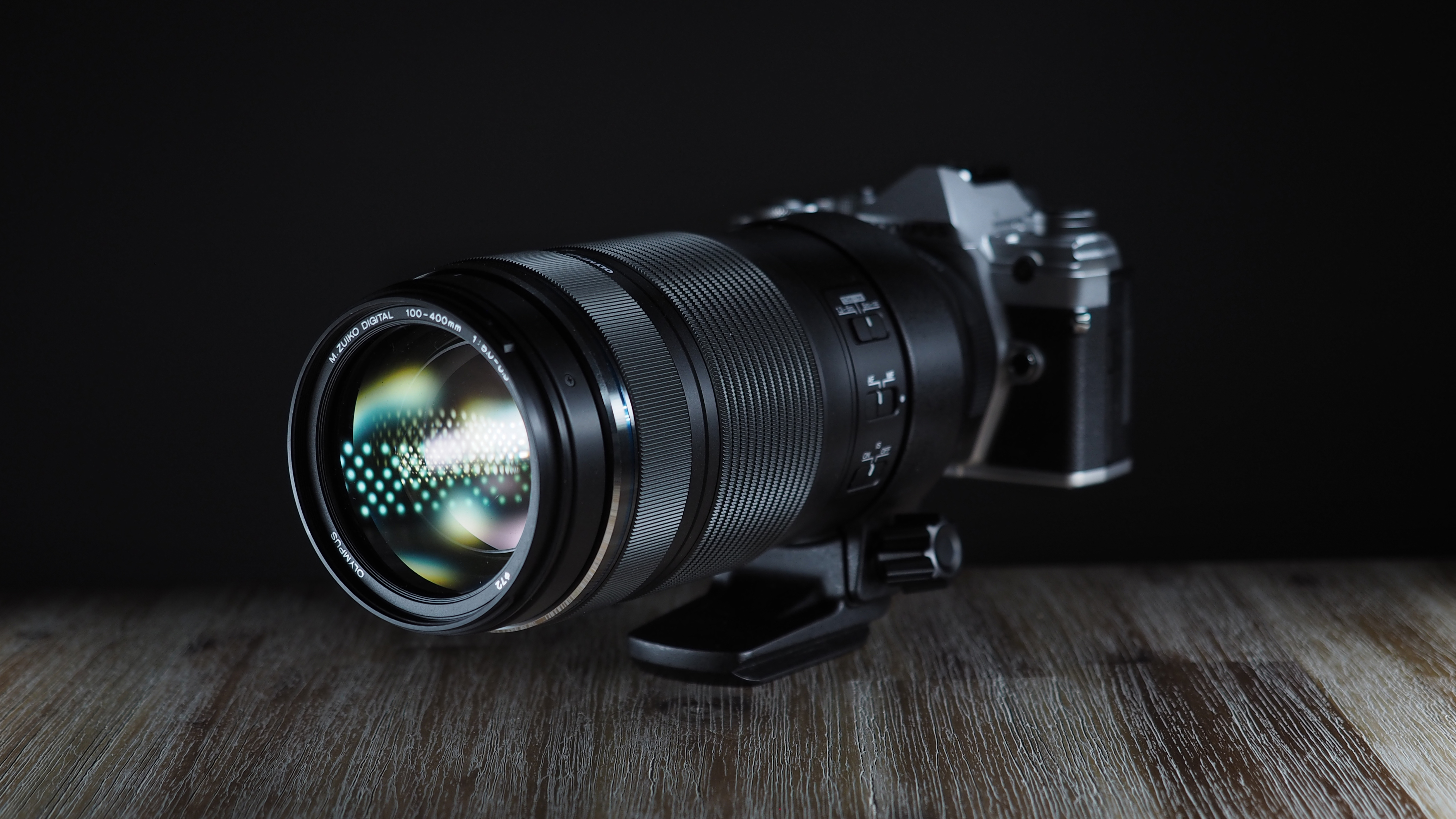
Build and handling
Again, this isn't an Olympus Pro lens, but it features a number of qualities typically reserved for those tip-top optics. Chief among these is the weather sealing, and the extensive hermetic sealing on the entire lens barrel to protect it no matter where you're shooting.
Thanks in large part to this, the build quality feels as rugged and robust as the manufacturer's Pro lenses. It's very solid and sturdy, with a smooth and consistent focus ring, but remains impressively light at just 1,120g – and as such it pairs well with smaller bodies, such as the Olympus OM-D E-M5 Mark III and the newly released Olympus OM-D E-M10 Mark IV.
The 100-400mm also features a focus clutch and a focus limiter, enabling you to select the operating range of the autofocus system. Next to this is an AF / MF switch to toggle auto or manual focus, and a switch to activate or deactivate the lens-based image stabilization system.

Performance
We've played with some spectacular zoom lenses in the last couple of months, including the superlative Nikon 120-300mm f/2.8E – which was an enormous hunk of glass that came with an eye-watering $9,499 price tag.
It's an extreme comparison, but nonetheless a timely reminder that this new Olympus lens is an f/5.6-6.3 optic with a $1,400 price tag. So it's important to remember what this lens is, and who and what it's intended for – lightweight, take-anywhere wildlife shooting for photographers eager to get a lot of reach without spending a lot of cash.
In that respect, it performs well. The compact and lightweight nature of the lens means that it's something you can easily travel with, enabling you to shoot in places where oversized optics would be far less practical.
The lens is generally able to capture good levels of detail, though as born out by our lab tests (below) the sharpness is a little disappointing – and obviously degrades the longer your chosen focal length.
Autofocus is snappy and reliable for stills, especially on Olympus bodies where the powerful AF and tracking systems of the Olympus OM-D E-M1 Mark III, E-M1X and E-M5 Mark III work well. Video AF is smooth and speedy as well, meaning that this is a great option for super telephoto footage.
The image stabilization arrangement is unusual, though, with it sometimes feeling as though the IBIS and lens IS are working against each other if you activate them both. We experienced better results using the lens stabilization at longer focal lengths (where IBIS is traditionally less potent) and body stabilization at the 'wider' end.
Consequently, and unsurprisingly for a super tele, your technique will be critical in getting clean images. Tripod-based shots are obviously free from the perils of amplified camera shake, but shooting handheld will require textbook form to ensure sharp shots.
Lab tests
We run a range of lab tests under controlled conditions, using the Imatest Master testing suite. Photos of test charts are taken across the range of apertures and zooms (where available), then analyzed for sharpness, distortion and chromatic aberrations.
We use Imatest SFR (spatial frequency response) charts and analysis software to plot lens resolution at the center of the image frame, corners and mid-point distances, across the range of aperture settings and, with zoom lenses, at four different focal lengths. The tests also measure distortion and color fringing (chromatic aberration).
Sharpness
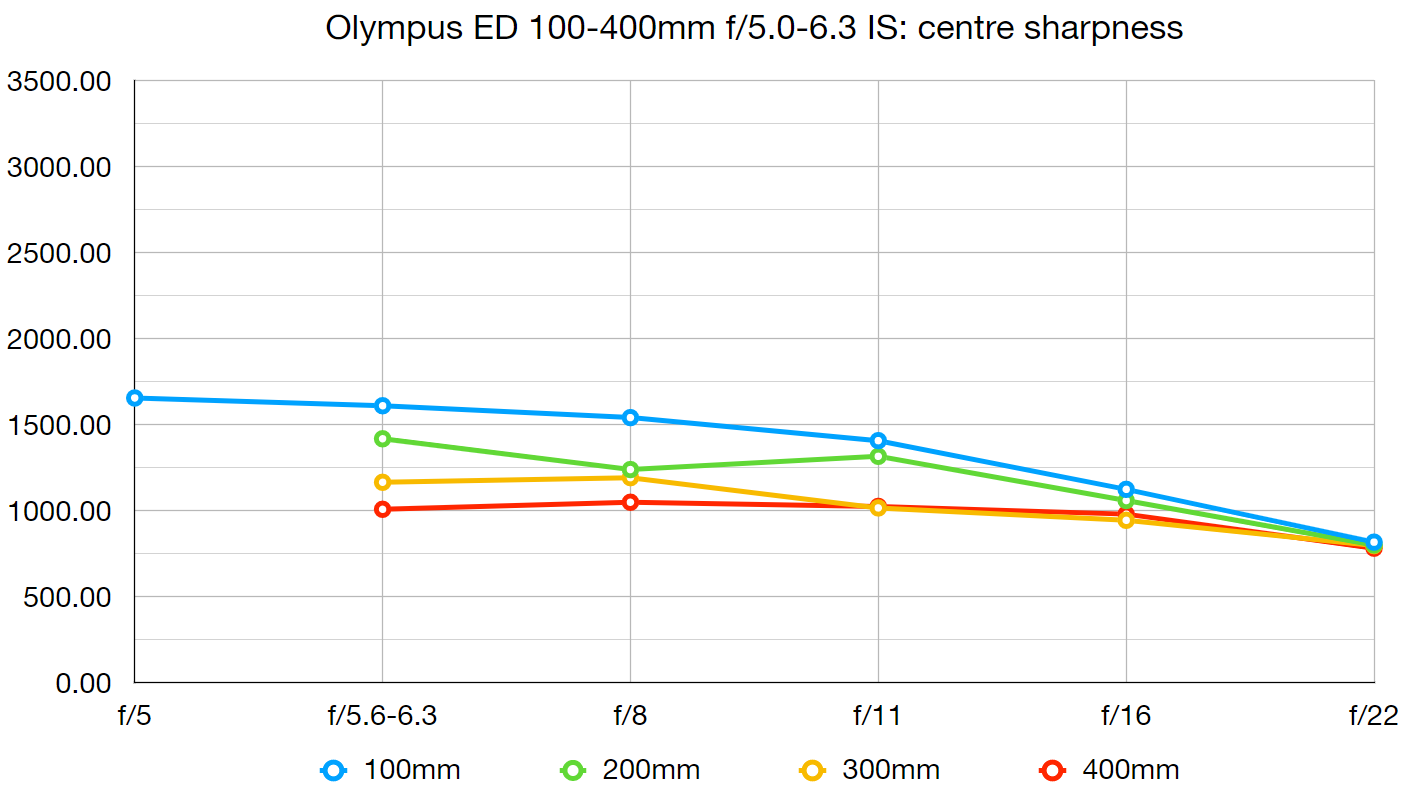
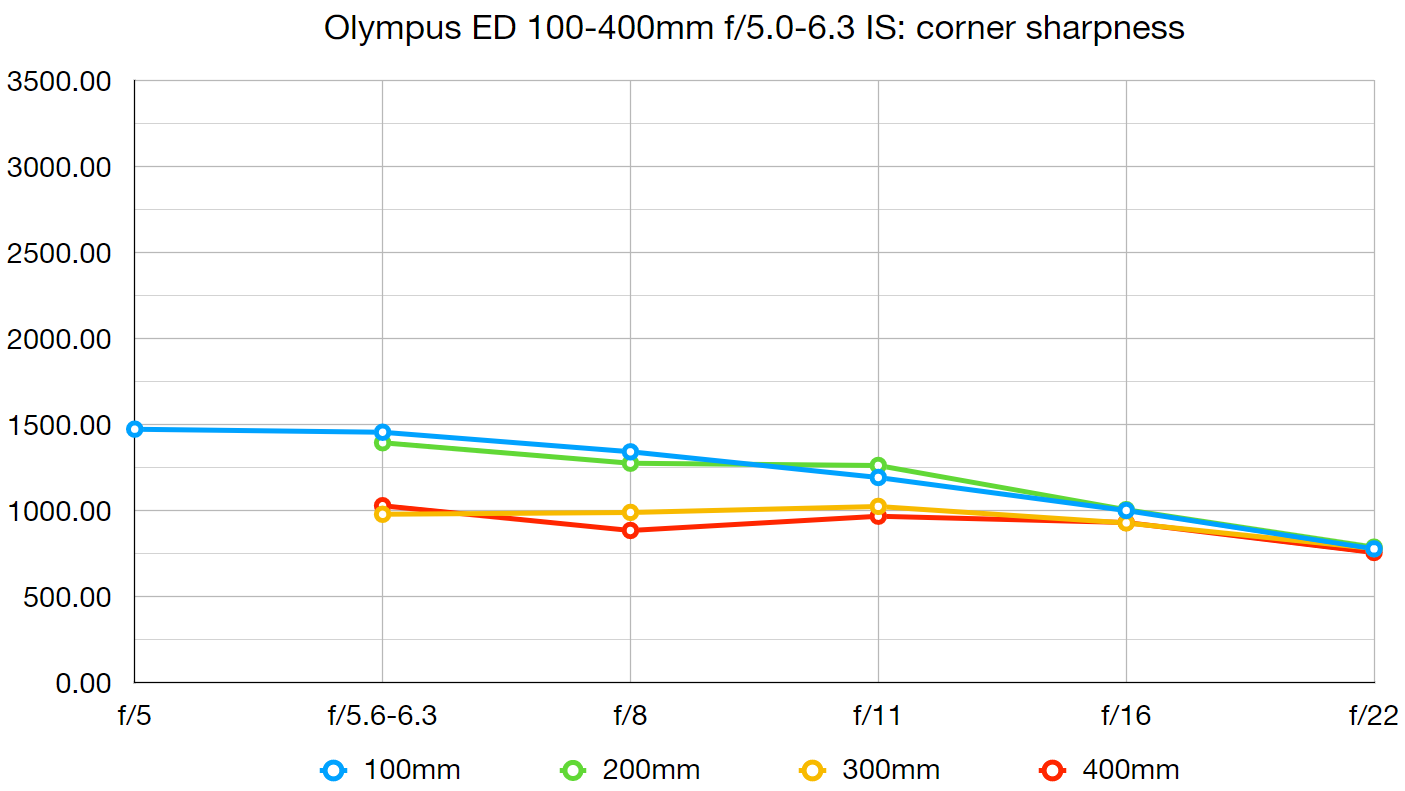
Centre sharpness is average at 100mm and slightly disappointing at longer focal lengths. It's the same story when it comes to corner sharpness, which is acceptable at 100mm and 200mm, but rather poor at 300mm and longer, regardless of the chosen aperture.
Fringing
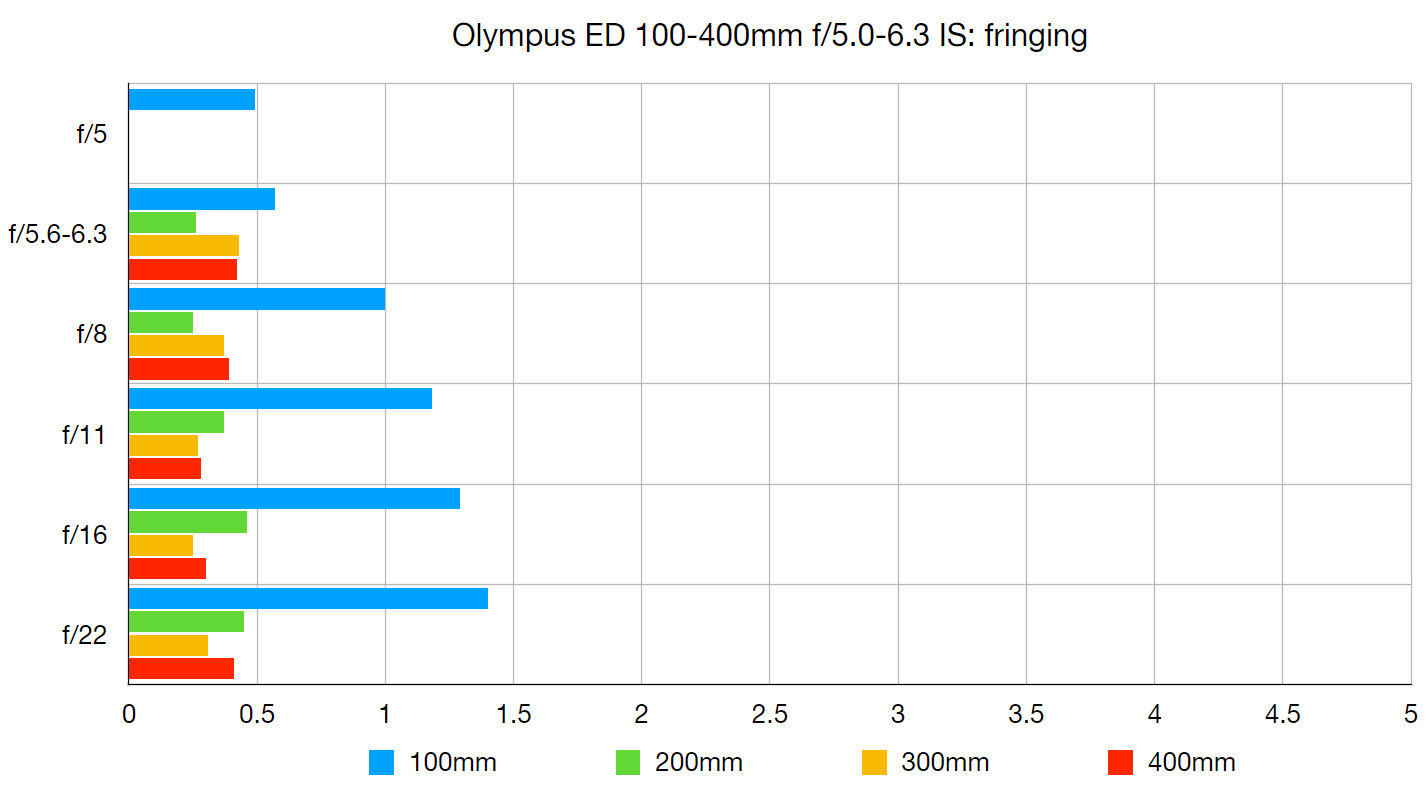
The lens does a good job of resisting chromatic aberration. It's just about visible at 100mm, though it's not distracting. At 200mm and above, levels of fringing are negligible and almost impossible to spot in real-world shooting.
Distortion
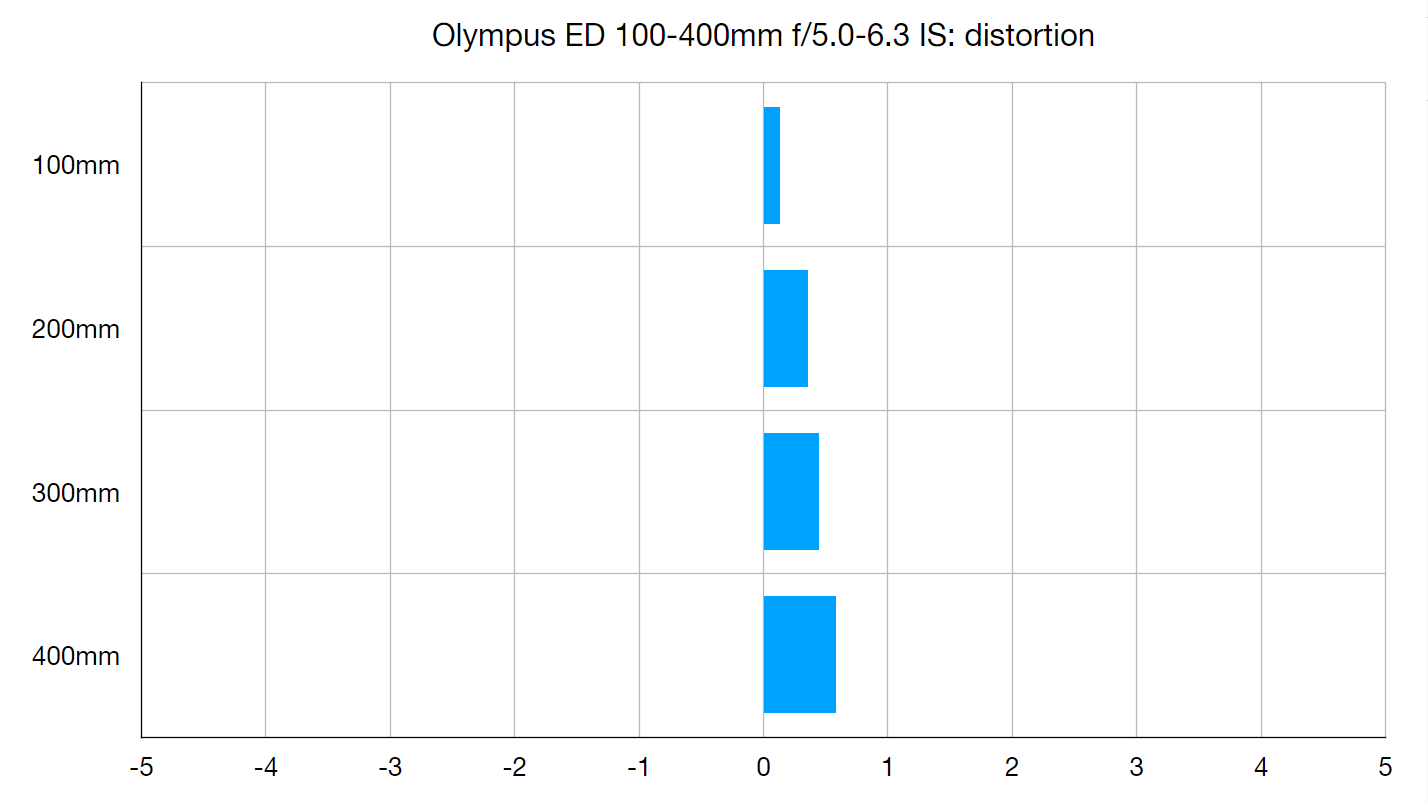
Thanks in large part to auto in-camera distortion correction, which can't be disabled, the lens produces very little distortion across its focal range. Only a trace of pincushion distortion is visible at longer focal lengths.
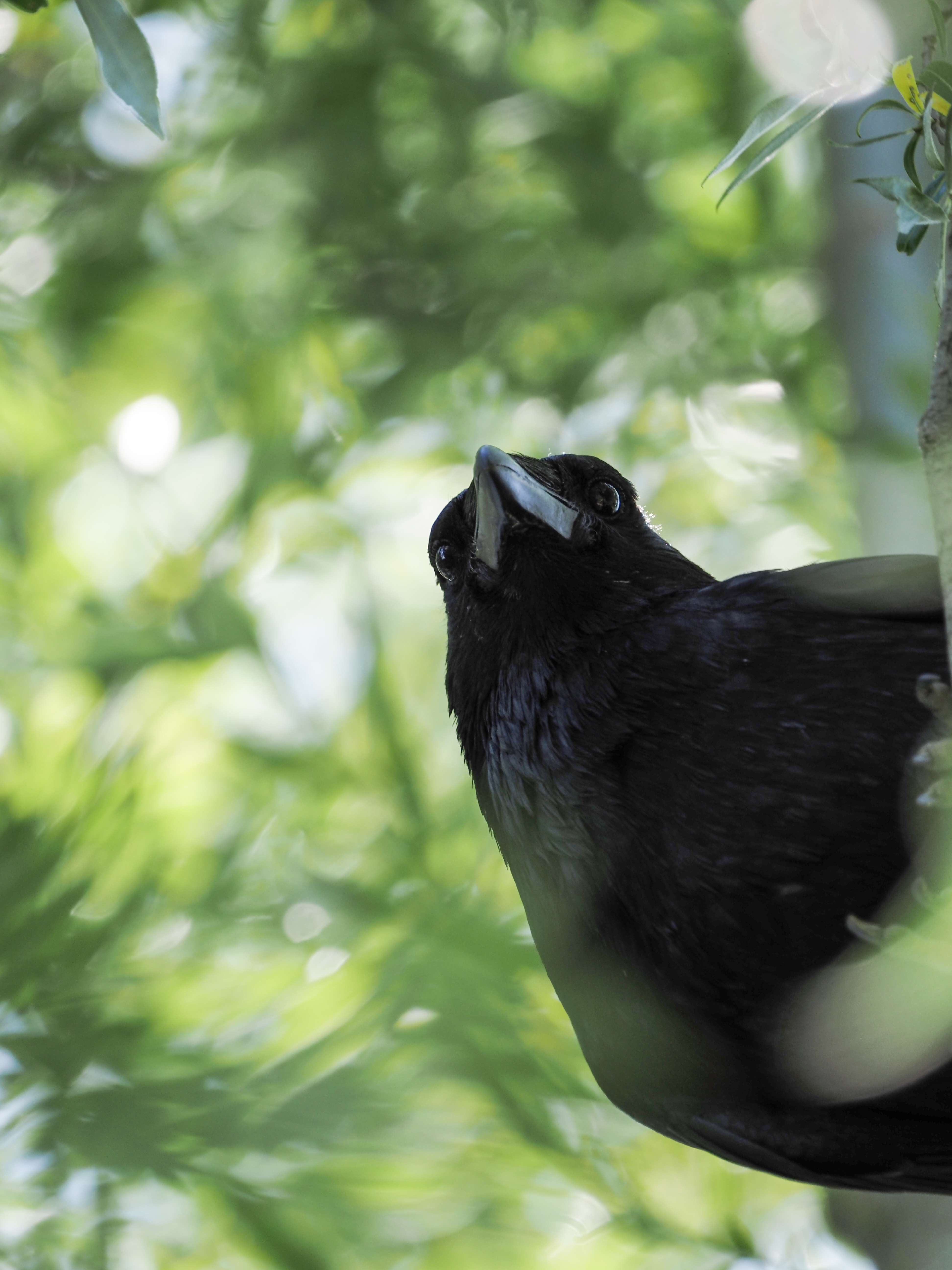
Verdict
As a non-Pro f/5.0-6.3 lens, the Olympus M.Zuiko 100-400mm f/5.0-6.3 IS delivers pleasing results overall – albeit with the usual caveats that it's not at its sharpest when shooting at its maximum focal length, and you can't expect an f/6.3 lens to achieve the same results as faster and more expensive glass.
There is a question of where this lens fits into the Micro Four Thirds ecosystem, given the existence of the Panasonic Leica 100-400mm f/4.0-6.3 and the upcoming Olympus M.Zuiko 150-400mm f/4.5 TC1.25x IS Pro.
While the latter will arrive this winter and possess a much higher price tag, thanks to its Pro designation, constant aperture and built-in teleconverter (giving it a ridiculous 2000mm reach), the Panasonic lens is available now for a comparable price – and is actually smaller, lighter, and has a brighter maximum aperture.
In favor of the Olympus 100-400mm is the fact that it supports the 1.4x and 2x teleconverters (which accounts for its increased size), as well as focus stacking and seamless AF on Olympus bodies – though we really wish that it featured Sync-IS (something that is reserved for Pro lenses like the 150-400mm).
In our opinion the Olympus lens offers more flexibility, and a better experience on OM-D cameras, and would be our pick between the two. For absolute sharpness the upcoming 150-400mm will no doubt reign supreme, but for portable 800mm images with performance on par with the price and speed, the Olympus 100-400mm f/5.0-6.3 is an easy lens to love for stills and video alike.
Sample images

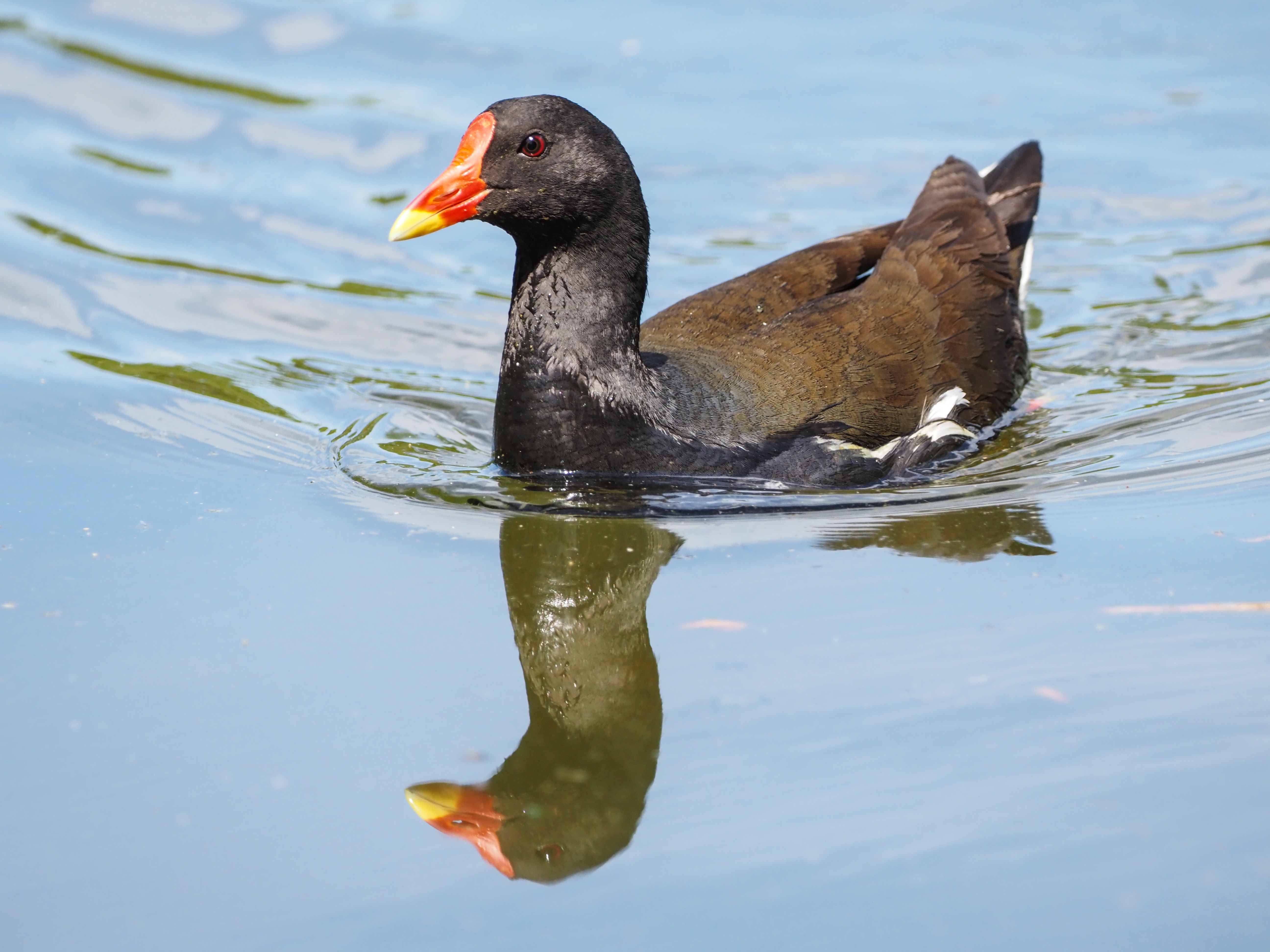



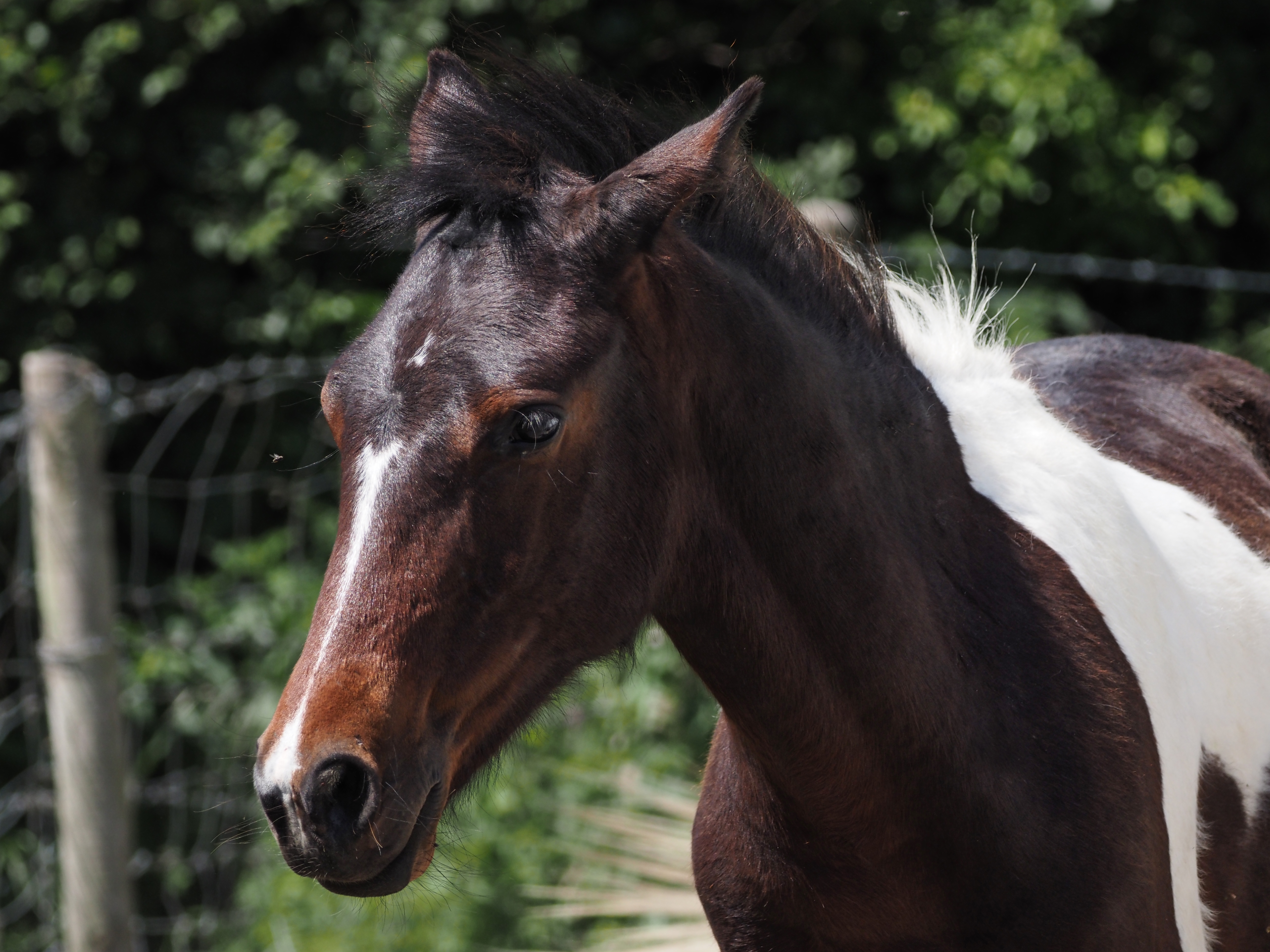


Pre-order Olympus M.Zuiko 100-400mm f/5.0-6.3 IS from Adorama (USA)
Pre-order Olympus M.Zuiko 100-400mm f/5.0-6.3 IS from B&H (USA)
Pre-order Olympus M.Zuiko 100-400mm f/5.0-6.3 IS from Park Cameras (UK)
Pre-order Olympus M.Zuiko 100-400mm f/5.0-6.3 IS from Wex (UK)
Pre-order Olympus M.Zuiko 100-400mm f/5.0-6.3 IS from Ted's Camera (Australia)
Read more:
Olympus OM-D E-M10 Mark IV review
The best Micro Four Thirds lenses: lenses for Olympus and Panasonic
The best 100-400mm lenses
The best Olympus camera: for Instagrammers, enthusiasts and pros
Olympus M.Zuiko Digital 2x Teleconverter MC-20 review

James has 22 years experience as a journalist, serving as editor of Digital Camera World for 6 of them. He started working in the photography industry in 2014, product testing and shooting ad campaigns for Olympus, as well as clients like Aston Martin Racing, Elinchrom and L'Oréal. An Olympus / OM System, Canon and Hasselblad shooter, he has a wealth of knowledge on cameras of all makes – and he loves instant cameras, too.
